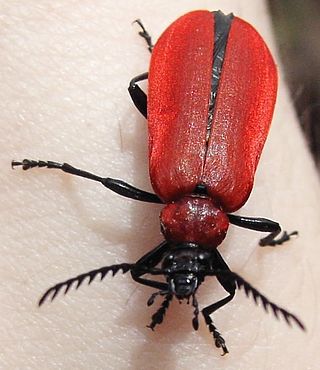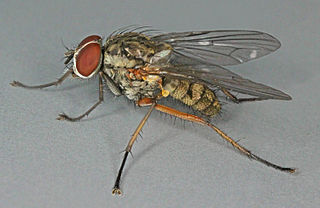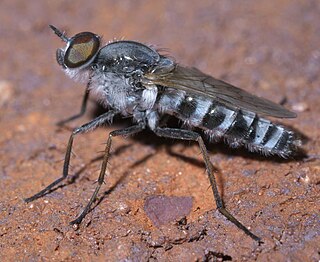
The Piophilidae are a family of "true flies", in the order Diptera. The so-called cheese flies are the best-known members, but most species of the Piophilidae are scavengers in animal products, carrion, and fungi. They may accordingly be important in forensic entomology and medical entomology. For a fly maggot, the larvae of many species have an unusually well-developed ability to leap when alarmed or when abandoning their larval food to pupate; they accordingly may be known as cheese skippers or other kinds of skippers according to their food source.

Biological databases are libraries of biological sciences, collected from scientific experiments, published literature, high-throughput experiment technology, and computational analysis. They contain information from research areas including genomics, proteomics, metabolomics, microarray gene expression, and phylogenetics. Information contained in biological databases includes gene function, structure, localization, clinical effects of mutations as well as similarities of biological sequences and structures.

Sphaerites is a genus of beetles, the only genus in the family Sphaeritidae, sometimes called the false clown beetles. There are five known species, which are widespread in temperate areas of the Northern Hemisphere, found in forested or upland areas.

Fire-coloured beetles is the common name for members of the tenebrionoid family Pyrochroidae. The family is found worldwide, and is most diverse at temperate latitudes. Adults measure 2–20 millimetres (0.079–0.787 in); larvae reach 35 millimetres (1.4 in). Larvae of Pyrochroinae are found associated with the bark of dead trees. They are probably mostly fungivorous, although they may become cannibalistic if too crowded.
The Catalogue of Life is an online database that provides an index of known species of animals, plants, fungi, and microorganisms. It was created in 2001 as a partnership between the global Species 2000 and the American Integrated Taxonomic Information System. The Catalogue is used by research scientists, citizen scientists, educators, and policy makers. The Catalogue is also used by the Biodiversity Heritage Library, the Barcode of Life Data System, Encyclopedia of Life, and the Global Biodiversity Information Facility. The Catalogue currently compiles data from 165 peer-reviewed taxonomic databases that are maintained by specialist institutions around the world. As of September 2022, the COL Checklist lists 2,067,951 of the world's 2.2m extant species known to taxonomists on the planet at present time.

The Encyclopedia of Life (EOL) is a free, online encyclopedia intended to document all of the 1.9 million living species known to science. It aggregates content to form "pages" for every known species. Content is compiled from existing trusted databases which are curated by experts and it calls on the assistance of non-experts throughout the world. It includes video, sound, images, graphics, information on characteristics, as well as text. In addition, the Encyclopedia incorporates species-related content from the Biodiversity Heritage Library, which digitizes millions of pages of printed literature from the world's major natural history libraries. The BHL digital content is indexed with the names of organisms using taxonomic indexing software developed by the Global Names project. The EOL project was initially backed by a US$50 million funding commitment, led by the MacArthur Foundation and the Sloan Foundation, who provided US$20 million and US$5 million, respectively. The additional US$25 million came from five cornerstone institutions—the Field Museum, Harvard University, the Marine Biological Laboratory, the Missouri Botanical Garden, and the Smithsonian Institution. The project was initially led by Jim Edwards and the development team by David Patterson. Today, participating institutions and individual donors continue to support EOL through financial contributions.
Empyelocera nigrimana is a species of ulidiid or picture-winged fly in the genus Empyelocera of the family Tephritidae.

Timia is a genus of flies in the family Ulidiidae, which is difficult to separate from the genus Ulidia.
Timia nigrimana is a species of ulidiid or picture-winged fly in the genus Timia of the family Ulidiidae.

Elaphropus is a genus of ground beetles in the family Carabidae. There are at least 370 described species in Elaphropus.

iNaturalist is an American 501(c)(3) nonprofit social network of naturalists, citizen scientists, and biologists built on the concept of mapping and sharing observations of biodiversity across the globe. iNaturalist may be accessed via its website or from its mobile applications. iNaturalist includes an automated species identification tool, and users further assist each other in identifying organisms from photographs and even sound recordings. As of 9 July 2024, iNaturalist users had contributed approximately 197,660,888 observations of plants, animals, fungi, and other organisms worldwide, and 290,007 users were active in the previous 30 days.

Hylemya nigrimana is a species of fly in the family Anthomyiidae. It is found in the Palearctic. For identification see:

Hylemya is a genus of root-maggot flies in the family Anthomyiidae. There are at least 30 described species in Hylemya.
Mumetopia is a genus of flies in the family Anthomyzidae. There are at least four described species in Mumetopia.
Prochyliza brevicornis is a species of cheese skippers, insects in the family Piophilidae.
Prochyliza is a genus of waltzing flies in the family Piophilidae. There are about 11 described species in Prochyliza.
Cladodromia nigrimana is a species of dance flies, in the fly family Empididae.
Acanthocnema is a genus of flies belonging to the family Scathophagidae.

Gymnochiromyia is a genus of flies belonging to the family Chyromyidae.

Ozodiceromyia is a genus of stiletto flies in the family Therevidae. There are about seven described species in Ozodiceromyia, found in North, Central, and northern South America.











